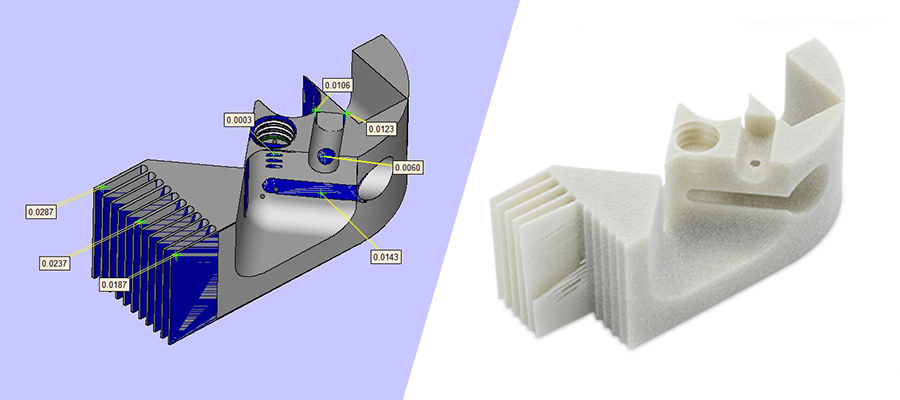Nylon 3D Printing Tips for Quality Parts
In industrial-scale 3D printing, part design has greater freedom and the ability to generate complex geometries compared to part design using more traditional manufacturing processes. When it comes to 3D printing nylon parts, however, there are five key considerations you should keep in mind to ensure that selective laser sintering (SLS) and multi-jet fusion (MJF) processes can produce the part you’re after.
When designing an SLS or MJF process with any of our powdered nylon materials, follow these brief design rules: Adhere to minimum feature size, minimize part warpage, minimize differential shrinkage, powder removal design, consult us for part end-use in order to Our process engineers advise you on process sequence optimization.
1.Minimum feature size for 3D printed nylon
We define the minimum feature size as the smallest surviving feature that reflects what is seen in the CAD model. The minimum feature size does not indicate how thin the layers in the part are. It refers to the size of the geometry that forms and survives the finishing process.
- Wall Thickness: Refers to the thickness in any direction on the part wall or geometry. Minimum allowable wall thickness is 0.030″ (0.762mm) for SLS and 0.020″ (0.508mm) for MJF.
- Channel Gap: This refers to the distance between two features. Channel gap is an important consideration when designing 3D printed nylon, because the sintering process can fuse the two features together regardless of channel gap. We recommend a minimum channel gap dimension of 0.030 inches (0.762 mm).
- Knife Edges: Consider designs with embedded features such as countersunk holes. Your size may fall below the minimum feature size at the far end of the hole. This may result in shortened or rounded features not forming correctly. Similar to wall thickness, we recommend making sure your distal features are at least 0.030″ (0.762mm) in SLS and 0.020″ (0.508mm) in MJF.
2.Minimize part warpage in SLS and MJF parts
Nylon powder 3D printing processes like SLS and MJF use heat to sinter powder into solid parts. The heat of manufacturing the part can also cause unwanted part warpage. Part size and overall thickness have the greatest impact on part warpage potential. Parts 7 inches (177.8 mm) and larger are more prone to bending. The thinner the part, and the closer it is to the minimum feature size overall, the more likely it is to warp. If you are concerned that warpage may be an issue in your design, we have 4 options for you below.
- Make parts close to a uniform thickness of 0.125″ (3.175 mm) to help ensure stability.
- Choose glass filled or mineral filled nylon such as PA 12 40% glass filled or PA 12 25% mineral filled (SLS material).
- If your parts are over 7 inches (177.8 mm) and you are concerned about warping, another option is to run unfilled nylon in an industrial grade SLS machine with a build range of 17.6*17.6*17 inches (447.04* 447.04*431.8mm).
- The last option is to print the part on industrial grade SLA machines which have a build range up to 29*25*21 inches (736.6*635*533.4mm).
3.Minimize shrinkage differences between SLS and MJF nylon parts
Similar to part warpage, different degrees of shrinkage occur when the part has an uneven distribution of material. This causes the part to thermally cool at a different rate when one side of the part is particularly thicker than the rest of the part. Thicker parts cool at a much slower rate than thinner areas, which can lead to unwanted part shrinkage.
If a thicker feature is required on the part, it is recommended that the feature be hollowed out to a shell of approximately 0.100 to 0.125 inches (2.54 to 3.185 mm). If possible, match the overall thickness of the part to the shell thickness of the large feature.
4.Powder removal of nylon 3D printed parts
A great way to take advantage of 3D printing is to minimize the material needed by including internal empty space in the part. In SLS and MJF processes, these areas will not have supports, but will have powder trapped in them. Trapped powder requires a drainage hole in the model to remove excess powder after the printing process is complete.
5.Let us help you with 3D printing nylon part positioning
Finalizing part orientation to enforce feature formation or prioritizing geometric accuracy is not as common practice for SLS or MJF as it is for SLA. We recommend that you have us orient your part to further help minimize the risk of minimal feature resolution or part warping.
